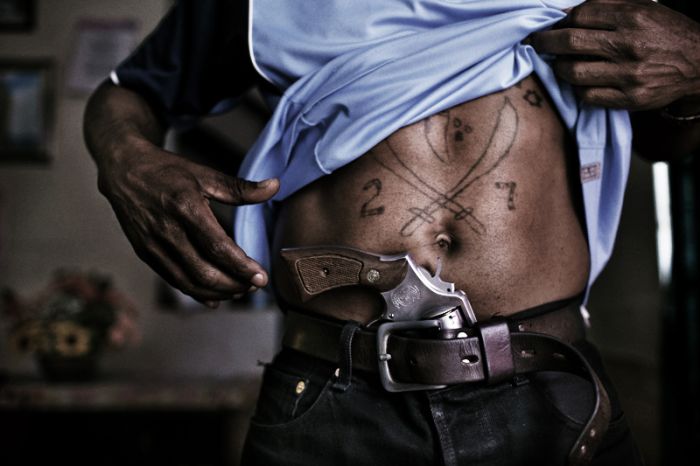“. . . if you know your enemies and know yourself, you will not be imperiled in a hundred battles; if you do not know your enemies but do know yourself, you will win one and lose one; if you do not know your enemies nor yourself, you will be imperiled in every single battle.” — Sun Tzu, “The Art of War”
A friend tipped me to a 5-year FBI study called “Violent Encounters: A Study of Felonious Assaults on Our Nation’s Law Enforcement Officers” (LEO). The Force Science Institute provides an excellent summary of one chapter of the FBI’s 180-page research summary. Please refer to these original sources and the Force Science Institute’s excellent website for the parameters of the study.
What I’d like to do here is present Tactical Tips from these summaries in a format that can be read in 2-minutes or less. That give folks a better chance of digestion even if it takes a few reads before they ‘seep in’.
Caveat in the Age of Doublespeak
As I’ve learned from Will Grigg’s meticulously chronicled accounts, any LEO could label as “Felonious Assault” the most benevolent civilian attempt to defend oneself against wrongful, even tyrannical, police force. However, I’m convinced the “Felonious Assaults” in this study describe the actions of gangsters (Of the non-government variety) that represent the most significant civilian gun-toting threat to the average American and certainly the officers at the core of this study.
Top 5 Most Disturbing Gangsta Tactics
The five most disturbing discoveries of the FBI’s study are that these ganstas:
- Have no hesitation whatsoever about pulling the trigger.
- Have more experience using deadly force in “street combat” than most police.
- Practice with firearms more often and shoot more accurately than the average police although tend to “Shoot for effect” without aiming in actual encounters.
- Nearly 70% of gangstas were successful (In getting rounds on target) with handguns, compared to about 40% of the victim officers, the study found.
- The street combat veterans (Gangstas) survived by developing a shoot-first mentality.
“If you hesitate,” one gangsta told the study’s researchers, “you’re dead. You have the instinct or you don’t. If you don’t, you’re in trouble on the street….”
Gangsta Training Film
The apparent stupidity and incompetence seen in this ‘gangsta training film’ deflects consideration of the tactics the FBI study has brings to light.
After you’re done laughing at these clowns consider the aspects of their behavior that are no laughing matter: Their shoot first mentality, shooting for effect without aiming, utter disregard for bystanders or even their own friends that could have been in the line of fire. And, notice the relative ease and carefree attitude with which they engage in their meaningless street combat.
Even a skilled armed citizen with full command of their composure and firearm would have difficulty getting off strategic, safe and legally justified shots in the situation in the video. I think such a citizen would defend themselves successfully. However, they would bear the burden of doing so within some very strict parameters.
Functioning within the narrow parameters of protecting lives is always more difficult than having no parameters, at all.
I agree with Karen De Coster that this video “is a reminder to those who carry a weapon for self-defense: consistently train with your weapon – mental preparation and defensive/combat/tactical training – so if you should ever have to engage thugs who wish to do you harm, you will have the superior preparation and skills, and the odds will be with you.”
Here’s the FBI’s conclusions about gangstas and guns after studying them for five years:
Weapon Choice
- Handguns, obtained illegally in street transactions or thefts.
- In contrast to media myth, none of the firearms in the study was obtained from gun shows.
- What was available “was the overriding factor in weapon choice”.
- None of the attackers interviewed was “hindered by any law–federal, state or local–that has ever been established to prevent gun ownership.
- The gangsta’s in the study “just laughed at gun laws”.
Familiarity
- The average age was 17 when they first started packing “most of the time.”
- Nearly 40% of the gangstas had some type of formal firearms training, primarily from the military.
- More than 80% “regularly practiced with handguns, averaging 23 practice sessions a year,”
- Practice was usually in informal settings like trash dumps, rural woods, back yards and “street corners in known drug-trafficking areas.”
- One spoke of being motivated to improve his gun skills by his belief that officers “go to the range two, three times a week [and] practice arms so they can hit anything.”
- Officers in the study averaged 2.5 qualifications per year. Only 6 of the 50 officers reported practicing regularly with handguns apart from what their department required.
- The gangstas practiced more often than the officers they assaulted, and this “may have helped increase [their] marksmanship skills,”
- The gangsta quoted above about his practice motivation, for example, fired 12 rounds at an officer, striking him 3 times. The officer fired 7 rounds, all misses.
- More than 40% of the gangstas had been involved in actual shooting confrontations before they feloniously assaulted an officer.
- Ten of these “street combat veterans,” all from “inner-city, drug-trafficking environments,” had taken part in 5 or more “criminal firefight experiences” in their lifetime.
- One reported that he was 14 when he was first shot on the street, “about 18 before a cop shot me.”
- Another said getting shot was a pivotal experience “because I made up my mind no one was gonna shoot me again.”
- Only eight of the 50 LEO victims had participated in a prior shooting; 1 had been involved in 2 previously, another in 3. Seven of the 8 had killed gangstas.
Concealment
- The gangstas said they most often hid guns on their person in the front waistband, with the groin area and the small of the back nearly tied for second place.
- Some occasionally gave their weapons to another person to carry, “most often a female companion.”
- None regularly used a holster, and about 40% at least sometimes carried a backup weapon.
- In motor vehicles, they most often kept their firearm readily available on their person, or, less often, under the seat.
- In residences, most stashed their weapon under a pillow, on a nightstand, under the mattress–somewhere within immediate reach while in bed.
- Almost all carried when on the move and strong majorities did so when socializing, committing crimes or being at home.
- About one-third brought weapons with them to work.
- Interestingly, the gangstas in this study more commonly admitted having guns under all these circumstances than did gangstas interviewed in the researchers’ earlier 2 surveys, conducted in the 1980s and ’90s.
- Male gangstas said time and time again that female officers tend to search them more thoroughly than male officers.
- In prison, most of the gangstas were more afraid to carry contraband or weapons when a female CO was on duty.
- On the street, however, both male and female officers too often regard female subjects “as less of a threat, assuming that they are not going to have a gun.
- In truth, the researchers concluded that more female gangstas are armed today than 20 years ago–“not just female gang associates, but female gangstas generally.”
Shooting Style
- Twenty-six of the gangstas [about 60%], including all of the street combat veterans, “claimed to be instinctive shooters, pointing and firing the weapon without consciously aligning the sights”.
- Gangstas frequently “Practice getting the gun out and using it”.
- Gangstas “Shoot for effect.” Or as one of the gangstas put it: “We’re not working with no marksmanship….We just putting it in your direction, you know….It don’t matter…as long as it’s gonna hit you…if it’s up at your head or your chest, down at your legs, whatever….Once I squeeze and you fall, then…if I want to execute you, then I could go from there.”
Hit Rate
- More often than the officers they attacked, gangstas delivered at least some rounds on target in their encounters.
- Nearly 70% of gangstas were successful (In getting rounds on target) with handguns, compared to about 40% of the victim officers, the study found. (Efforts of gangstas and officers to get on target were considered successful if any rounds struck, regardless of the number fired).
- Gangstas “Might have had an advantage because in all but 3 cases they fired first, usually catching the officer by surprise”.
- “10 of the total victim officers had been wounded [and thus impaired] before they returned gunfire at their attackers.”
Missed Cues
- Officers would less likely be caught off guard by attackers if they were more observant of indicators of concealed weapons, the study concludes.
- These particularly include manners of dress, ways of moving and unconscious gestures often related to carrying.
- “Officers should look for unnatural protrusions or bulges in the waist, back and crotch areas,” the study says, and watch for “shirts that appear rippled or wavy on one side of the body while the fabric on the other side appears smooth.”
- In warm weather, multilayered clothing inappropriate to the temperature may be a giveaway.
- On cold or rainy days, a subject’s jacket hood may not be covering his head because it is being used to conceal a handgun.
- Because they eschew holsters, gangstas reported frequently touching a concealed gun with hands or arms “to assure themselves that it is still hidden, secure and accessible” and hasn’t shifted”.
- Such gestures are especially noticeable “whenever individuals change body positions, such as standing, sitting or exiting a vehicle”.
- If they run, they may need to keep a constant grip on a hidden gun to control it.
- Just as cops generally blade their body to make their sidearm less accessible, armed criminals “do the same in encounters with LEOs to ensure concealment and easy access.”
- Officers who are assigned to look for concealed weapons, while working off-duty security at night clubs for instance, are often highly proficient at detecting them. “But then when they go back to the street without that specific assignment, they seem to ‘turn off’ that skill,” and thus are startled–sometimes fatally–when a suspect suddenly produces a weapon and attacks.
Mind-Set
- Thirty-six of the 50 officers in the study had “experienced hazardous situations where they had the legal authority” to use deadly force “but chose not to shoot.” They averaged 4 such prior incidents before the encounters that the researchers investigated.
- “It appeared clear that none of these officers were willing to use deadly force against an gangsta if other options were available”.
- The gangstas were of a different mind-set entirely. In fact, the study team “did not realize how cold blooded the younger generation of gangsta is. They have been exposed to killing after killing, they fully expect to get killed and they don’t hesitate to shoot anybody, including a police officer.
- They can go from riding down the street saying what a beautiful day it is to killing in the next instant.
- “gangstas typically displayed no moral or ethical restraints in using firearms”.
- The street combat veterans (Gangstas) survived by developing a shoot-first mentality.




